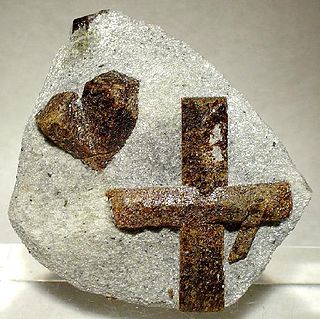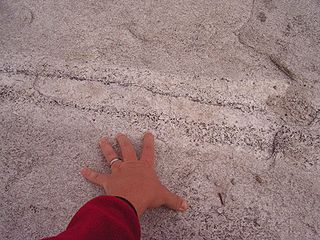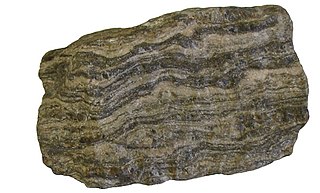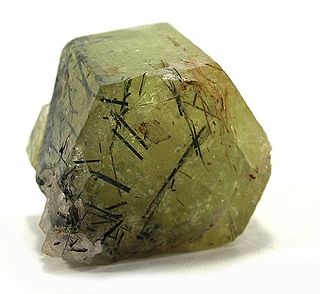
Metamorphism is the change of minerals or geologic texture in pre-existing rocks (protoliths), without the protolith melting into liquid magma. The change occurs primarily due to heat, pressure, and the introduction of chemically active fluids. The chemical components and crystal structures of the minerals making up the rock may change even though the rock remains a solid. Changes at or just beneath Earth's surface due to weathering or diagenesis are not classified as metamorphism. Metamorphism typically occurs between diagenesis, and melting (~850°C).

The lithology of a rock unit is a description of its physical characteristics visible at outcrop, in hand or core samples, or with low magnification microscopy. Physical characteristics include colour, texture, grain size, and composition. Lithology may refer to either a detailed description of these characteristics, or a summary of the gross physical character of a rock. Lithology is the basis of subdividing rock sequences into individual lithostratigraphic units for the purposes of mapping and correlation between areas. In certain applications, such as site investigations, lithology is described using a standard terminology such as in the European geotechnical standard Eurocode 7.

Staurolite is a red brown to black, mostly opaque, nesosilicate mineral with a white streak. It crystallizes in the monoclinic crystal system, has a Mohs hardness of 7 to 7.5 and the chemical formula: Fe2+2Al9O6(SiO4)4(O,OH)2. Magnesium, zinc and manganese substitute in the iron site and trivalent iron can substitute for aluminium.

A xenolith is a rock fragment that becomes enveloped in a larger rock during the latter's development and solidification. In geology, the term xenolith is almost exclusively used to describe inclusions in igneous rock during magma emplacement and eruption. Xenoliths may be engulfed along the margins of a magma chamber, torn loose from the walls of an erupting lava conduit or explosive diatreme or picked up along the base of a flowing body of lava on the Earth's surface. A xenocryst is an individual foreign crystal included within an igneous body. Examples of xenocrysts are quartz crystals in a silica-deficient lava and diamonds within kimberlite diatremes. Xenoliths can be non-uniform within individual locations, even in areas which are spatially limited, e.g. rhyolite-dominated lava of Niijima volcano (Japan) contains two types of gabbroic xenoliths which are of different origin - they were formed in different temperature and pressure conditions.

A phenocryst is an early forming, relatively large and usually conspicuous crystal distinctly larger than the grains of the rock groundmass of an igneous rock. Such rocks that have a distinct difference in the size of the crystals are called porphyries, and the adjective porphyritic is used to describe them. Phenocrysts often have euhedral forms, either due to early growth within a magma, or by post-emplacement recrystallization. Normally the term phenocryst is not used unless the crystals are directly observable, which is sometimes stated as greater than .5 millimeter in diameter. Phenocrysts below this level, but still larger than the groundmass crystals, are termed microphenocrysts. Very large phenocrysts are termed megaphenocrysts. Some rocks contain both microphenocrysts and megaphenocrysts. In metamorphic rocks, crystals similar to phenocrysts are called porphyroblasts.

Metasomatism is the chemical alteration of a rock by hydrothermal and other fluids. It is the replacement of one rock by another of different mineralogical and chemical composition. The minerals which compose the rocks are dissolved and new mineral formations are deposited in their place. Dissolution and deposition occur simultaneously and the rock remains solid.

Chiastolite is a variety of the mineral andalusite with the chemical composition Al2SiO5. It is noted for distinctive cross-shaped black inclusions of graphite. In areas around Georgetown, California, metamorphosed sediments contained andalusite and chiastolite in a graphite rich metasediment. The chiastolite crystals have been pseudomorphically altered by a mixture of muscovite, paragonite and margarite. The calcium rich margarite tends to form along the graphite rich crosses or bands within the chiastolite. Mineralogically the occurrence is important because all three white mica phases are present in an equilibrium assemblage.

Relative dating is the science of determining the relative order of past events, without necessarily determining their absolute age. In geology, rock or superficial deposits, fossils and lithologies can be used to correlate one stratigraphic column with another. Prior to the discovery of radiometric dating in the early 20th century, which provided a means of absolute dating, archaeologists and geologists used relative dating to determine ages of materials. Though relative dating can only determine the sequential order in which a series of events occurred, not when they occurred, it remains a useful technique. Relative dating by biostratigraphy is the preferred method in paleontology and is, in some respects, more accurate. The Law of Superposition, which states that older layers will be deeper in a site than more recent layers, was the summary outcome of 'relative dating' as observed in geology from the 17th century to the early 20th century.

Shear is the response of a rock to deformation usually by compressive stress and forms particular textures. Shear can be homogeneous or non-homogeneous, and may be pure shear or simple shear. Study of geological shear is related to the study of structural geology, rock microstructure or rock texture and fault mechanics.
Rock microstructure includes the texture of a rock and the small scale rock structures. The words "texture" and "microstructure" are interchangeable, with the latter preferred in modern geological literature. However, texture is still acceptable because it is a useful means of identifying the origin of rocks, how they formed, and their appearance.
In a geological context, crenulation or crenulation cleavage is a fabric formed in metamorphic rocks such as phyllite, schist and some gneiss by two or more stress directions causing the formation of the superimposed foliations.

Foliation in geology refers to repetitive layering in metamorphic rocks. Each layer can be as thin as a sheet of paper, or over a meter in thickness. The word comes from the Latin folium, meaning "leaf", and refers to the sheet-like planar structure. It is caused by shearing forces, or differential pressure. The layers form parallel to the direction of the shear, or perpendicular to the direction of higher pressure. Nonfoliated metamorphic rocks are typically formed in the absence of significant differential pressure or shear. Foliation is common in rocks affected by the regional metamorphic compression typical of areas of mountain belt formation.

A porphyroclast is a clast or mineral fragment in a metamorphic rock, surrounded by a groundmass of finer grained crystals. Porphyroclasts are fragments of the original rock before dynamic recrystallisation or cataclasis produced the groundmass. This means they are older than the groundmass. They were stronger pieces of the original rock, that could not as easily deform and were therefore not or hardly affected by recrystallisation. They may have been phenocrysts or porphyroblasts in the original rock.

Augen are large, lenticular eye-shaped mineral grains or mineral aggregates visible in some foliated metamorphic rocks. In cross section they have the shape of an eye.
Granoblastic is an adjective describing an anhedral phaneritic equi-granular metamorphic rock texture. Granoblastic texture is typical of quartzite, marble and other non-foliated metamorphic rocks without porphyroblasts. Characteristics defining granoblastic texture include: grains visible to the unaided eye, sutured boundaries and approximately equidimensional grains. The grain boundaries intersect at 120° triple junctions under ideal conditions. Variation from the ideal results from stress produced foliation during crystallization resulting in schistose textures.
In geology, a megacryst is a crystal or grain that is considerably larger than the encircling matrix. They are found in igneous and metamorphic rocks. Megacrysts can be further classified based on the nature of their origin, either as:
The law of included fragments is a method of relative dating in geology. Essentially, this law states that clasts in a rock are older than the rock itself. One example of this is a xenolith, which is a fragment of country rock that fell into passing magma as a result of stoping. Another example is a derived fossil, which is a fossil that has been eroded from an older bed and redeposited into a younger one.













